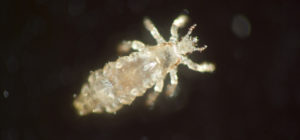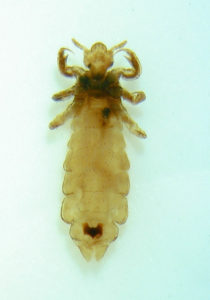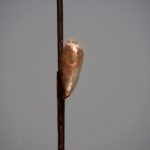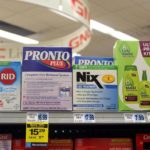General Information
 Head lice, Pediculus capitis, infest 10-12 million people (most commonly children three to twelve years of age) each year in the United States. Pediculosis or “lousiness” is one of the most prevalent communicable conditions in this country. Head lice are primarily transferred from person to person by direct head-to-head contact or by several people using the same combs, brushes, hats, costumes, head-phones, athletic equipment, towels, or bedding.
Head lice, Pediculus capitis, infest 10-12 million people (most commonly children three to twelve years of age) each year in the United States. Pediculosis or “lousiness” is one of the most prevalent communicable conditions in this country. Head lice are primarily transferred from person to person by direct head-to-head contact or by several people using the same combs, brushes, hats, costumes, head-phones, athletic equipment, towels, or bedding.
Head lice are not found on animals or household pets and are not transmitted from pets to humans. Because of children’s play activity and close contact, head lice infestations are usually found on children, but can also be spread to adults. Head lice are not vectors of disease in the United States although severe infestations may cause irritation, scratching, and subsequent secondary infection. Students can lose sleep, feel embarrassed, and even suffer anxiety. Itching from large numbers of bites may make the infested individual feel tired, irritable, and feverish, thus the term “feeling lousy”.
The reaction of individuals to louse bites can vary considerably. Persons previously unexposed to lice experience little irritation when contracting head lice for the first time. After a few weeks some individuals may become sensitized to the bites and react with a general allergic reaction including reddening of the skin, itching, and overall inflammation. Subsequent infestations usually cause itching and redness within 24-48 hours. Some individuals never exhibit symptoms even with repeated infections.
Identification
 Adult head lice are small (2.5–3 mm long), dorso-ventrally flattened and entirely wingless. The thoracic segments are fused, but otherwise distinct from the head and abdomen, the latter being composed of seven visible segments. Head lice are grey in general, but their precise color varies according to the environment in which they were raised. After feeding, consumed blood causes the louse body to take on a reddish color. The eggs of lice are called nits. They are oval white cylinders (1/16 inch long). The eggs of head lice are usually glued to hairs of the head near the scalp. The favorite areas for females to glue their eggs are near the ears and back of the head. The egg must feed within 24 hours or they will die.
Adult head lice are small (2.5–3 mm long), dorso-ventrally flattened and entirely wingless. The thoracic segments are fused, but otherwise distinct from the head and abdomen, the latter being composed of seven visible segments. Head lice are grey in general, but their precise color varies according to the environment in which they were raised. After feeding, consumed blood causes the louse body to take on a reddish color. The eggs of lice are called nits. They are oval white cylinders (1/16 inch long). The eggs of head lice are usually glued to hairs of the head near the scalp. The favorite areas for females to glue their eggs are near the ears and back of the head. The egg must feed within 24 hours or they will die.
Female lice lay 6-10 eggs (nits) per day. She may lay up to 140 eggs during her 30 day lifetime. Adults cannot survive more than about 24 hours without a blood meal. The nymphs and adults all have piercing-sucking mouthparts, which pierce the skin for a blood meal.
Suggested Thresholds
Known outbreak reported at school campus, with confirmation by school nurse.
Monitoring and Inspection
- Head lice spread principally from person to person. Human louse infestation, called

Nits attach to hair follicles
pediculosis, can spread rapidly and may reach epidemic proportions if left unchecked. Head lice are highly dependent upon human body warmth and will die if separated from their host for 24 hours. Head lice prefer to live on the hair of the head although they have been known to wander to other parts of the body. Head lice do not normally live within rugs, carpet, or school buses. Children. however, should be encouraged not to share combs, hats, head-phones, ear-buds, blue-tooth devises or other personal belongings.
- Periodic inspections aids in early detection of head lice. Early detection will prevent advanced infestations which are much more difficult to control. Children are best inspected during the early weeks of school (August – November) since outbreaks are most common during this time.
- An adult louse can move 6 to 30 cm per minute. They are hard to see and very difficult to remove. Nits are easier to spot, especially at the nape of the neck or behind the ears. Unhatched eggs will be within 1 cm of the scalp. In general, nits found more than 1 cm from the scalp are unlikely to be viable. In warmer climates however, viable nits can occur farther from the scalp.
- The presence of active, living lice in a student’s head is the only definitive indication of an infestation that should trigger a head treatment.
- If an active infestation is noted, the child’s parent or guardian should be notified immediately. Treatment options may be suggested. Other members of the family should inspect each other along with children who regularly sleep-over or share hair apparel (hair clips, head-sets, hats, etc.). Parents and school nurses should be encouraged to recheck the student’s head for lice after treatments have occurred if the child is still showing signs of infestation.
Nonchemical Control Measures
Due to the short time period that head lice can survive off the head, transmission occurs most commonly with head-to-head contact, which should be avoided. To further reduce potential for transmission – discourage sharing of combs, brushes, headbands, barrettes, pillows, hats, scarves, coats, helmets, backpacks or other objects that may come in contact with the head.
- Where possible place hats, scarves, and coats on widely spaced hooks or in separate lockers or cubbies to avoid contact.
- If hooks are shared or clustered, have children place their coats and hats in sealed plastic bags, especially if head lice are present.
- Hats and scarves can also be stored inside backpacks.
- Assigning seal-able containers for each student is also a way to keep items seperate.
Sanitation/Cultural Control Measures
During outbreaks of head lice, in addition to stressing the preventative measures mentioned above, it is also useful for students to bag their hats and coats between use or keep them in personal lockers or at their chairs. Though head lice do not survive long away from their human host they can crawl short distances, say, from one hat to another on a hat rack.
Bean bag chairs, nap mats or other stuffed furniture that children share should be removed temporarily from classrooms during outbreaks. Sharing of sports helmets and audio headphones can also contribute to the spread of head lice among students.
Pesticides applied to classrooms, lockers or buses are ineffective, unnecessary and can be harmful to students and teachers.
Physical/Mechanical Control Measures
Once an infestation is detected through inspection:
- All clothing in the family should be washed in soapy water and dried on a high heat.
- If outbreak occurs in a classroom where clothing is used/shared be sure to clean them as well.
- Pillow cases, sheets, blankets and other bedding material should also be washed and placed in the clothes dryer on the “high heat” cycle for at least 20 minutes to kill the lice and their eggs.
- Carpets, furniture, car seats and any non-washable items such as children’s toys should be thoroughly vacuumed and the vacuum bag immediately discarded outside of the home.
- Anything that cannot be vacuumed may be tightly sealed in plastic bags for at least 7-10 days and placed in a bright sunny area. This elevates the temperature in the bag and kills all stages of the lice.
Chemical Control Measures

Products sold for control of head lice prices will vary depending on your location. This image is used for illustration purposes.
Because of the biology of the head louse and its increasing resistance to available lice-killing (pediculicide) shampoos, relying on these products alone is not likely to be effective. An integrated approach including the preventative measures mentioned above, regular head inspections by school nurses, advisories encouraging parents to do daily head checks, manual lice removal with special louse and nit combs, and the judicious use of pediculicides is the best approach to managing infestations. Note that efforts to educate both students and their parents about these pests and their control is a crucial part of a good IPM program for head lice.
Always read and follow the label directions on lice-killing shampoos and chemicals very, very carefully. Never deviate from the directions and always wear the appropriate personal protective equipment if you are applying pediculicide shampoos. Improper use can harm people.
Screening for head lice in schools is a very useful role for the school health professional. Generally, around 30% of school children with nits will also have adult lice. Screening for nits alone is not an accurate way of predicting which students will need head treatments. The presence of active lice in a student’s head is the only definitive indication that should trigger a head treatment. If an active infestation is noted, the child’s parent or guardian should be notified immediately.
Parents and school nurses should be encouraged to recheck the student’s head for lice after treatments have occurred if the child still has signs of an infestation.
The American Academy of Pediatrics and the National Association of School Nurses discourage “no nit” policies in schools. There is no need to send students home. See this website for more information – Pediculosis Management in the School Setting. Check location regulations since policies vary.
Parents of all students using the room with any child with confirmed head lice should also be notified and provided with basic information including description, signs and symptoms, and strategies to eliminate headlice. The information should include where to go for additional help.
Authors: Faith Oi, Rebecca Baldwin, Janet Hurley.
